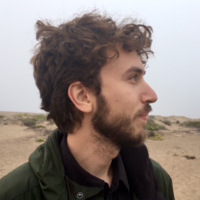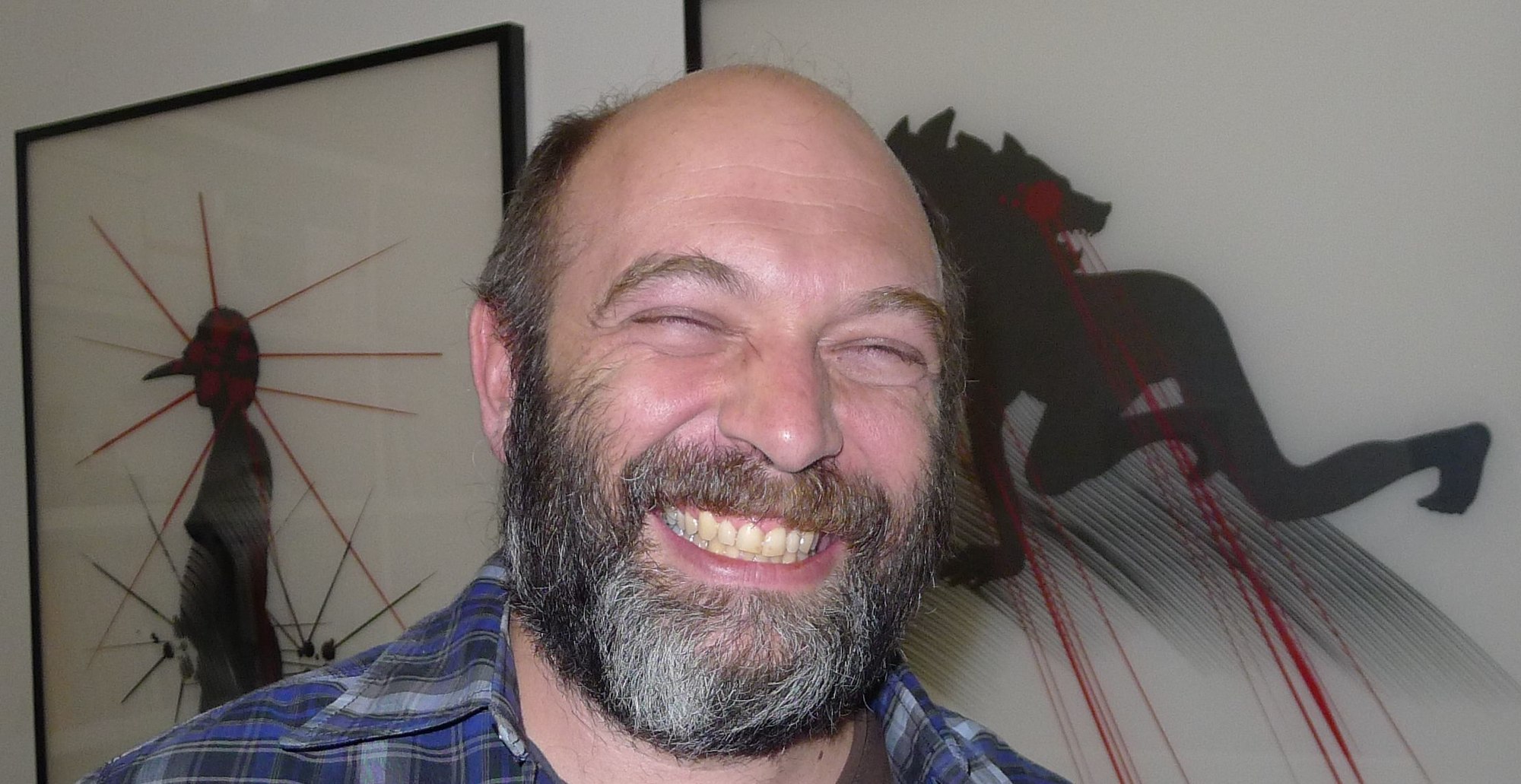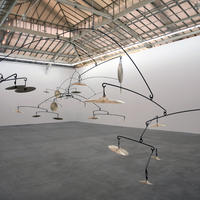More about Carlos Amorales
Works by Carlos Amorales

Contributor
Let’s call Carlos Amorales the Great Deconstructor.
Born and raised in Mexico City, Mexico in the 1970s, Amorales has made a name for himself as an artist of symbols. In fact, perhaps his most well known work is the Liquid Archive, an ongoing (perhaps eternal) database of imagery pulled from historical research and personal experience. By the imagery’s mere existence in this collection, and their repeated use, reinterpretation and even reformation, they become symbols freed of context. In a way, they have been deconstructed to their graphic roots.
Doesn’t he sound like the Great Deconstructor, an artistic wrestler? Take a moment and imagine Amorales in a fight against a symbol. Then look up Amorales vs. Amorales and you’ll realize that he already did this. Like a great wrestler, he’s two steps ahead and has knocked you out. But then he took it even further – he wrestled a masked figure designed in his own image, but as a luchador, a mexican wrestler wrapped up in its own symbols and myths.
This is not to say that the symbol is something to devalue in his work. His work, on the other hand, explores the possibility of an image beyond its traditional meaning and context.
He’s a multimedia artist at heart. He’s created film, photography, sculpture, collages. He’s done installations and murals, too. He’s fascinated with the world of the imaginary, and a lot of his work seems to be about the creative process itself. Just look at Amorales vs. Amorales. Many works are punctuated by references to music, and he also has produced merchandise that begs the question of what a modern artist is.
His work has been loudly cheered in the art scene. Recently, he represented his country of Mexico at the 57th Venice Biennale in 2016. Before that, he was recognized at the Shanghai Biennale, the Berlin Biennial, and the Moscow Biennial, among many others. Amorales is an artist of the moment, and he isn’t stopping anytime soon. ¡Ojo! The Great Deconstructor is among us.
Sources
- Reyes, Juan Antonio Álvarez. "Carlos Amorales." ArtNexus. Accessed April 30, 2019. http://www.artnexus.com/Notice_View.aspx?DocumentID=18500.
- Taylor, Jessica. "Carlos Amorales." Frieze. Accessed April 2019. https://frieze.com/article/carlos-amorales.
- "SFMOMA Presents Amorales Vs. Amorales (challenge 2003) A Masked Wrestling Performance." SFMOMA Presents Amorales Vs. Amorales (challenge 2003) A Masked Wrestling Performance · SFMOMA. Accessed April 30, 2019. https://www.sfmoma.org/press/release/sfmoma-p

Featured Books & Academic Sources
This interview was conducted by Matt Marcure via email correspondence with Carlos Amorales at the midpoint of April 2019.
It sprang up as a conversation about his new work at the Berkeley Art Museum, which you can check out here. Forgive the stiffness of questions, this was an email interview, afterall. Let's begin:
Matt Marcure: Something that stuck out to me about Ghost Demonstration was its relationship to the archive: the slogans are pulled from a physical collection of information regarding Berkeley protests to random locales of data found on the internet. The archive is a potent element of your work, with the voluminous collection of digital drawings found in your Liquid Archive coming to mind. What role do you think the archive will play, or should play, in the future of art? To go even further, how does art created from an archive relate to the modern self’s relationship to memory, to history, if at all?
Carlos Amorales: I am an artist who is interested in cinema, therefore I conceive and use the archive from that perspective. I think that using an archive helps me structure my work, and make sense of it as a narrative. In this sense, the archive becomes a vault of information that I can resource every time that I start a project.
In the early nineties, when I was studying in Europe, there wasn't an art history available besides what had happened in places like North America and Europe. As a non western artist I felt that I had to write a history of my own, and look for references that personally interested me. When I began working with the wrestler´s fictional persona (an avatar) and I was stepping into a new field outside the art world, I became aware of the importance of leaving traces behind me, like an anthropologist. As it wasn't yet clear to me, what the artistic outcome of this project would be, it became necessary to archive documents, objects, photos and videos to keep a record of this process. It was only some years later that all this material made sense in the form of a book. If I had not archived the evidence of my research, I would have not been able to tell the story of what I had produced.
Today we gather evidences of our existence in an online timeline, producing autobiographical narratives that reveal our personal history but also our desires. Desiring is about the future, so in this sense and from a behaviorist perspective, archiving has become more about foreseeing and influencing the future of people than about the value of their own history. I guess today´s artist that use archives must deal with this dichotomy: the edition of a version of what has happened or the possibility of influencing what will happen. It is just like the classic division of cinema: documentary or fiction.
MM: Ghost Demonstration is similar to an exhibition you did with fashion designer Steph Orozco and musician Enrique Arriaga called Protesta Fantasma. What made you want to return to the design of this work? Do you see the two pieces as connected, or as separate entities with unique interests?
CA: Yes. This is because I work in a way that is based in the process, the extension through time and the displacement in space. Originally I made some paper works in 2012 where I introduced the idea of using the bodies of people as stencils for airbrush painting. Last year, in a survey exhibition that I had in a museum in Mexico City, I took this idea further, and I decided to work with the museographers to create the silhouettes while the were holding the artworks, so with this gesture, the piece became like a ghost exhibition. It was from seeing these silhouettes arranged in a room that I got the idea of having them hold protests signs, and that lead to the idea of a ghost demonstration. The first test was in that collaborative exhibition in Monterrey that you mention, then I pushed the idea further for the Art Wall commission in Berkeley, next week I am going to paint a new one in Lille, in the north of France. I think that the Ghost Demonstration image should function like a meme, in the sense that it should “appear and re appear” in different parts of the world as real protest do. We are living in a troubled world that has become very challenging to understand, the ghosts are there to remind us of our history and to reflect in the present and think about the future.
In each place that the Ghost Demonstration has appeared it resonates differently, according to the history of the place. In Berkeley of course its an image that relates to the historical demonstrations in the university, but also to the recent ones. For the one in France it has been an interesting discussion because it has raised questions in relation to the Gilets Jaunes. In Monterrey it enabled to resurface a very dramatic accident that happened in the exhibition space when it used to be an industrial foundry, many decades ago. One of the large containers turned over, spilling the melted steel over the workers, disintegrating them and leaving the marks of their evaporated bodies on the walls, as it happened during the bombing of Hiroshima. When seeing the exhibition, an older journalist remembered that incident and told us the story. We where surprised and touched because we didn’t know about it, what made us believe that we kind of functioned like mediums. In relation to your first question, I am amazed that a story that happened in pre internet times and which was buried in the memory of older people, could surface thanks to the images. Perhaps this is one positive aspect of art, that can still evoke memories that are not part of the digital world.
MM: I am curious about your selection process. What appealed to you about intertwining the geo-specific histories of Berkeley protest signs with the lyrics, the shibboleths, of British anarcho-punk bands from the 80’s? How do these distinct histories elevate, clarify, and perhaps even confuse the other?
CA: I choose the Berkley slogans for their historical importance and and to show how claims have developed through different political movements until the present. t. In the other hand I was attracted to tAnti Neoliberal protest in England from the eighties, movements like Bash the Rich and the anarchist magazine Class War, which where the first protests of this kind. Poisson Girls and Crass, the Anarcho Punk bands, took part in this movement. The slogans that I made out of their songs are a different voice, a voice that is existential, personal and ironic. In the mural they function like the inner voice of the people, while the political slogans represent the collective voice of a movement. They confuse each other because although the collective voice of the masses is unilateral, the masses are still made out of individuals, with personal histories and positions.
MM: On the use of lyrics, music often plays a role in your work. We’ll See How Everything Reverberates is a great example of this. It leads me to recall a line from The Falconer, the debut novel from Dana Czapnik, where a character, who is a visual artist, says something to the effect that music is the art that best achieves beauty because it is not incumbent upon representation of some sort (symbols, signifiers, and so forth). What do you think of a statement like this?
CA: Music is often thought of as a clearing in the jungle of signs, as it has an abstract quality that can free our minds from making sense and also appeals directly to our emotions. But in singing the voice can become truly political, and that is why political songs are so important, because they make us emotional about our political beliefs and ideology. Singers can be as powerful as some political or religious leaders. Beyond this of course it is possible to politicise music, not in itself but thinking about it´s context in Duchampian terms: the ritual of playing and listening to music can imply the questions of how, to whom and where.
MM: Ghost Demonstration, in its form, from what I understand, is inspired by Mexican mural art. For me, it is the most compelling repurposing of BAMPFA’s art wall. Certainly the most striking. What are your thoughts on this piece being in a University museum? It lends a certain inner/outer dichotomy to the piece which appears to be reflected in the slogans themselves, like “I am ideologically uncool” and “the masses are between us”.
CA: Thank you! Given the conditions of the wall and where it is placed in the museum, as part of the auditorium, I had to refer myself to Mexican mural art. This was the first time I ever did such a consideration, as of the generation of Mexican artists that I´m part of, we have a very distanced position towards those historical artists and their murals, since we see them as totalitarian figures of power. As we are today in a moment when ideologies are unclear and complex. I introduced an ambiguous position towards ideology. The relation between the individual and the masses is a constant theme in my work, which I treat ironically.
The fact that the mural is made in the context of a university makes it much stronger. II have to say that the Art Wall commission has been a very interesting challenge, as I had to look to classical art, thinking about composing with the human figure in a large scale. When the scaffolding was finally taken away I felt amazed by the powerful frontally of the mural and how openly political murals can still be nowadays, yet for surviving in todays world one has to keep a certain ironical distance, I mean irony not as a cool attitude, but as a strong element blended together with love and affection.
MM: Presented slogans like “don’t U C us” and “MAKE RACISTS AFRAID AGAIN” could be from this very moment. Do you think there is a cautionary element to this piece, something akin to the phrase the more things change, the more they stay the same? Is Ghost Demonstrations meant to be a positive piece?
CA: Such slogans are very recent, they refer to problems that we are facing today, not only in the USA but worldwide. What became evident to me by seeing all the slogans from historical demonstration assembled together is that, although claims have changed, the unrest that began with the generation of the sixties is still present today. We are not facing the draft, nor claiming for the basic freedom of speech, but in a strange way, although society was changed, it still feels to be a darker place. Unrest is confusing us and its making us afraid of using the public space for speaking with others. Ghosts are there and they can talk to us, but they will not listen when we reply, ghosts are as deaf as a wall…
Featured Content
Here is what Wikipedia says about Carlos Amorales
Carlos Amorales (Mexico City, 1970) is a multidisciplinary artist who studied at the Gerrit Rietveld Academy and the Rijksakademie in Amsterdam. The most extensive researches in his work encompass Los Amorales (1996-2001), Liquid Archive (1999–2010), Nuevos Ricos (2004–2009), and a typographic exploration in junction with cinema (2013–present).
Check out the full Wikipedia article about Carlos Amorales











